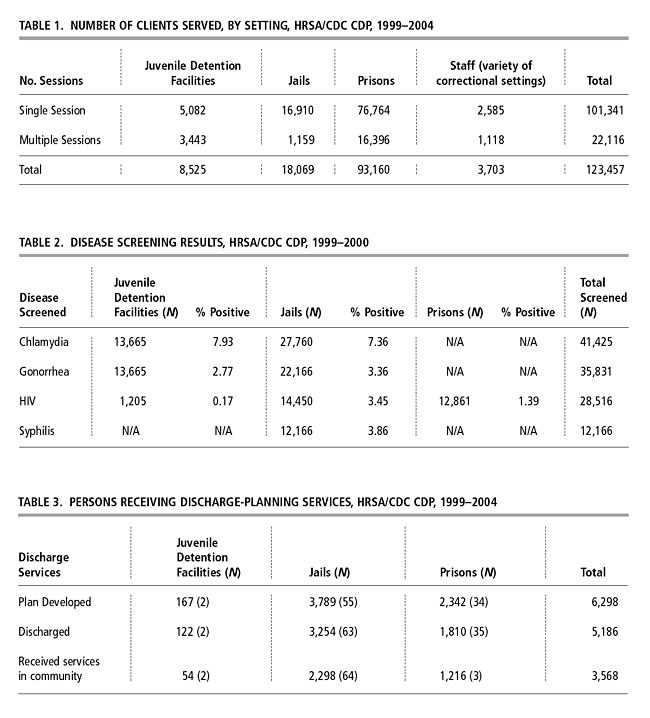 |
 |
| U.S. Department of Health and Human Services • Health Resources and Services Administration • HIV/AIDS Bureau • December 2007 | |
| INTRODUCTION |
| THE CORRECTIONS INITIATIVE |
| AGGREGATE FINDINGS |
| PARTICIPATING PROJECTS |
| SUMMARY |
| SUSTAINABILITY |
| APPENDIX: OUTCOME STATISTICS |
| PUBLISHER |
AGGREGATE FINDINGS
During 5 years of prevention and case service delivery, the CDP provided HIV, STI, and hepatitis prevention education to more than 123,000 people, disease-screening services to more than 41,000 clients, and discharge-planning and community case management services to nearly 7,000 PLWHA (Tables 1 and 2).
HIV, STI, and hepatitis prevention education was offered in juvenile detention, local jail, and State prison settings. In some areas, staff in those institutions also were offered prevention education. Nearly everyone who received prevention education was located in a State prison setting; far fewer people in local jails and juvenile detention centers received prevention education.
Disease screening was offered in most of the settings in which prevention education was presented, often as a follow-up to the classes. The number of tests carried out for particular diseases is known; however, clients may have been tested more than once. Among juveniles, chlamydia and gonorrhea were the most frequently screened diseases (13,655 tests each), followed by HIV infection (1,205 tests). Chlamydia was the most often identified infection (7.93 percent of tests were positive), and HIV was quite rare (0.17 percent of tests were positive) among juveniles (Table 2).
Adults who were screened in county jail settings revealed a similar pattern of disease prevalence. Chlamydia was the most frequently recorded test (N = 27,760) and displayed the highest positive rate (7.36 percent, almost identical to the rate for juveniles), followed by gonorrhea (N = 22,166; 3.36 percent positive). Although fewer HIV tests than other types of STI screens were conducted (N = 14,450), the percentage positive (3.45 percent) was slightly higher than the percentage of positive gonorrhea tests. Syphilis tests were the least frequently reported among the jails and had a positive rate of 3.86 percent. Rates of HIV and syphilis are higher among adults primarily because of the additional risk factors associated with substance abuse that are not as predominate among juveniles.
State prisons tested only for HIV, perhaps because of the probability that other STIs would have been detected and treated in county jails, through which most State prisoners pass prior to coming to prison. Over the course of the project, participating prisons conducted 12,861 HIV tests. Only 1.39 percent of the prison tests were positive. The rate is much lower for prison populations than jail populations because prisons have a more stable population that should have already been medically evaluated and treated for most infectious diseases prior to admission. Jails, however, represent the community, and the flow of people in and out results in a much higher rate of positive tests because of behavioral risk factors.
The CDP focused primarily on linking prisoners living with HIV to services inside the correctional setting, discharge-planning services, and community case management services after release. Table 3 shows that 6,298 prisoners had discharge plans prepared by project staff (mostly CBO staff). Most prisoners for whom discharge plans were developed (55 percent) were in jail settings. Nearly 75 percent (5,186) of the inmates for whom plans were developed were released back into the community during the CDP. Of those, 69 percent (3,568) received at least one service from CDP providers in the community.
